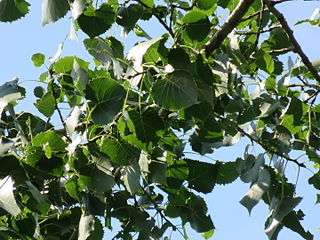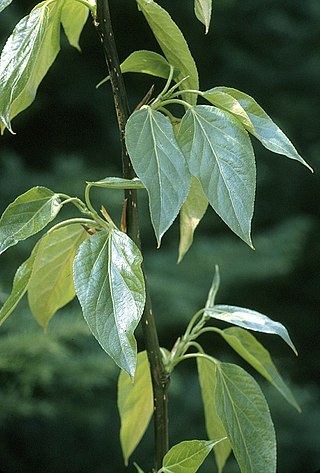
In the United States, national forest is a classification of protected and managed federal lands that are largely forest and woodland areas. They are owned collectively by the American people through the federal government and managed by the United States Forest Service, a division of the United States Department of Agriculture. The U.S. Forest Service is also a forestry research organization which provides financial assistance to state and local forestry industry. There are 154 national forests in the United States.

Fraxinus americana, the white ash or American ash, is a fast-growing species of ash tree native to eastern and central North America.

Pinus sabiniana, with vernacular names including towani pine, foothill pine, gray pine, bull pine, and digger pine, is a pine endemic to California in the United States. Some sources discourage using the name "digger pine," considering it pejorative.

Pinus contorta, with the common names lodgepole pine and shore pine, and also known as twisted pine, and contorta pine, is a common tree in western North America. It is common near the ocean shore and in dry montane forests to the subalpine, but is rare in lowland rain forests. Like all pines, it is an evergreen conifer.

Pinus serotina, the pond pine, black bark pine, bay pine,marsh pine, or pocosin pine, is a pine tree found along the Southeastern portion of the Atlantic coastal plain of the United States, from southern New Jersey south to Florida and west to southern Alabama. Pond pine distribution may be starting to spread west towards Mississippi and Tennessee.

The shortleaf pine or Pinus echinata is a species of coniferous tree endemic to the United States. The shortleaf pine is sometimes referred to as the "old field", "spruce", "rosemary", "yellow", "two-leaf" and "heart" pine. The common name "shortleaf pine" may refer to other species like loblolly pine, based on a custom in the Southeastern United States to only refer to pines as either "long-leaf" or "short-leaf". However, P. echinata can be distinguished from other pines by examining its short leaves and small cones.

Pinus clausa is a species of pine endemic to the Southeastern United States. Its common names include sand pine, Florida spruce pine, and scrub pine.

Pinus ponderosa, commonly known as the ponderosa pine, bull pine, blackjack pine, western yellow-pine, or filipinus pine, is a very large pine tree species of variable habitat native to mountainous regions of western North America. It is the most widely distributed pine species in North America.

Quercus douglasii, known as blue oak, is a species of oak endemic to California, common in the Coast Ranges and the foothills of the Sierra Nevada. It is California's most drought-tolerant deciduous oak, and is a dominant species in the blue oak woodland ecosystem. It is occasionally known as mountain oak and iron oak.

The blue spruce, also commonly known as green spruce, Colorado spruce, or Colorado blue spruce, is a species of spruce tree native to North America in Arizona, Colorado, Idaho, New Mexico, Utah and Wyoming. It is noted for its blue-green colored needles, and has therefore been used as an ornamental tree in many places far beyond its native range.

Taxodium distichum is a deciduous conifer in the family Cupressaceae. It is native to the southeastern United States. Hardy and tough, this tree adapts to a wide range of soil types, whether wet, salty, dry, or swampy. It is noted for the russet-red fall color of its lacy needles.

Populus tremuloides is a deciduous tree native to cooler areas of North America, one of several species referred to by the common name aspen. It is commonly called quaking aspen, trembling aspen, American aspen, mountain or golden aspen, trembling poplar, white poplar, and popple, as well as others. The trees have tall trunks, up to 25 metres tall, with smooth pale bark, scarred with black. The glossy green leaves, dull beneath, become golden to yellow, rarely red, in autumn. The species often propagates through its roots to form large clonal groves originating from a shared root system. These roots are not rhizomes, as new growth develops from adventitious buds on the parent root system.

Populus deltoides, the eastern cottonwood or necklace poplar, is a species of cottonwood poplar native to North America, growing throughout the eastern, central, and southwestern United States as well as the southern Canadian prairies, the southernmost part of eastern Canada, and northeastern Mexico.
Didymopanax is a genus of flowering plants in the family Araliaceae, native to southern Mexico, Central America, the Caribbean, and South America. It was resurrected from Schefflera in 2020.

Tecoma stans is a species of flowering perennial shrub in the trumpet vine family, Bignoniaceae, that is native to the Americas. Common names include yellow trumpetbush, yellow bells, yellow elder, ginger Thomas. Tecoma stans is the official flower of the United States Virgin Islands and the floral emblem of The Bahamas.

Populus balsamifera, commonly called balsam poplar, bam, bamtree, eastern balsam-poplar, hackmatack, tacamahac poplar, tacamahaca, is a tree species in the balsam poplar species group in the poplar genus, Populus. The genus name Populus is from the Latin for poplar, and the specific epithet balsamifera from Latin for "balsam-bearing".

Randia aculeata, commonly known as white indigoberry or white indigo berry, is a species in the Rubiaceae. It is a shrub or small tree that grows from 2 to 6 m tall. R. aculeata is native to Florida, Bermuda, the Bahamas, elsewhere among the Caribbean islands, and also from Mexico south through Central and South America to Colombia.
Yagrumo is a South American term for some unrelated rainforest trees with palmate leaves:

Diospyros maritima is a tree in the family Ebenaceae. The specific epithet maritima means 'by the sea', referring to the tree's habitat.
The Murici Ecological Station is an ecological station in the state of Alagoas, Brazil. It preserves a rugged area of Atlantic Forest that is important as a home for several species of rare or endangered birds.


















